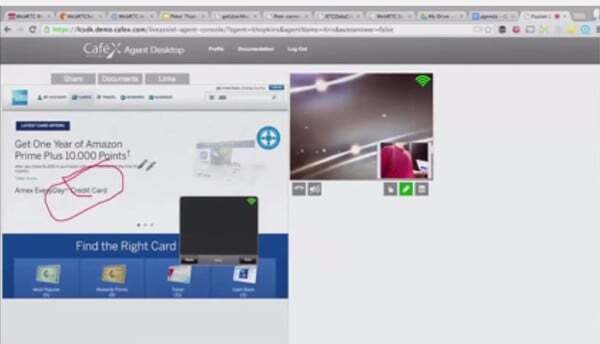American Express shows the way for the future of communication.
Enterprise Connect 2015 was a rather sad event. While I enjoyed it immensely, it was mostly filled with vendors who are unaware of what goes on around them (around being outside of their Unified Communication comfort zone). That’s a story for another time though.
I want to share with you the best session I had at Enterprise Connect. At the Conference within a Conference part, which was WebRTC on the first day, the Real-World WebRTC Deployments session had Brian Barnes – Vice President, World Service & Global Credit Administration Technology at American Express.
He shared his thoughts wisdom with the listeners about their recent deployment of a self service video support capability within their mobile app.
The system is based on CafeX technology and Cisco.

The CafeX AMEX demo at a WebRTC meetup in Boston (available on YouTube)
AMEX is looking to offer customers service in their channel of choice – the omnichannel story for AMEX isn’t one about starting a session on one channel (phone) and then switching to continue the interaction on another channel (web) – it is about giving the selection to the customer of picking up his channel, but with the belief the customer will continue to use that channel for the whole interaction instead of switching.
So AMEX set about taking WebRTC, embedding it in their iPad app and soft launching it. Not making too much buzz or advertising it. Just making it available for those who “find” it. They wanted to look at those who use it and see their complete customer journey.
They estimated 8% of the sessions won’t connect, due to this being an IP based technology. That is what they experienced in their production later on as well. 92% success rate was better than nothing for them.
Brian gave rapid fire statistics about the service. I didn’t capture it all, but here are a few things I did write down:
- AMEX customers from 44 countries used the service. While their customers are US based, they use it all over the globe
- Many of the calls took place from Afghanistan. While there is no real cellular service to speak of that soldiers could use, Internet via WiFi was available, and made that capability in the AMEX self service app both useful and popular
- 12% of those using the service did so in the last 60 days – people like using this service
- 1% of the market. That’s how big that is. While small, Brian said that satisfying that 1% is what makes it worth it for the other 99%. It is about uncompromising on customer service
- 67% of those using the service opted for 2-way video. The service starts off with a video coming from the agent only and allows the customer to open his video if he so wishes. Most did it out of courtesy – being polite made sense
- 88% got first call resolution, which ends up being a positive experience for the customers
- It also meant an average handling time of 5 minutes on that channel
- One of the reasons for the high resolution rate is the fact that this call passes context with it, enabling the agent to skip all the initial questions of identity and the reason for calling
Why did AMEX do this if it is used so little? There were a few reasons he gave on stage.
- It is a high touch, distinguishing experience. It differentiates AMEX from the other financial institutes in the US
- They took an initial step to test the waters. The idea was to test and learn
AMEX will probably be using this experience and knowledge they gain when they move forward. Brian stressed the point of having to focus on the WHY – the business case – not the technology. I fully agree. There are too many vendors out there building stuff with WebRTC without really thinking the business case through, not understanding if and how much value it brings.
WebRTC wasn’t really mentioned in his speech, and yet, this is only possible with WebRTC as a technology:
- AMEX wouldn’t find a company such as CafeX who could offer them the same capabilities and features at a similar price point if it weren’t for WebRTC
- WebRTC was used here on an iOS device – in mobile – inside an app. Not the first thing people think about when it comes to WebRTC, but from my latest research into this exact topic – a natural occurrence
- WebRTC enables AMEX in the future to open that service through their websites as well – it is just a matter of making that decision

This is a very accurate and well written summary of a compelling session. One clarification though: I believe AMEX estimated that 30 percent of their customers would not be able to connect due to technology issues. In fact, Mr. Barnes reported that the success rate for connectivity reached 92 percent, which far surpassed their expectations.
Glenn,
Thanks for commenting. At his session, Brian Barnes specifically mentioned the 8% – as something that they estimated before launch as well.
I think the initial estimations are less interesting than the fact that WebRTC is ubiquitous enough that a company such as AMEX decided to embrace and launch a commercial service with it, and that at the end of the day they’ve seen a connectivity success rate of 92% of the attempts.